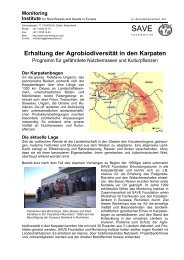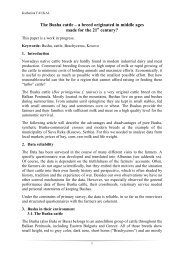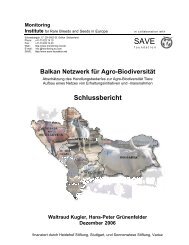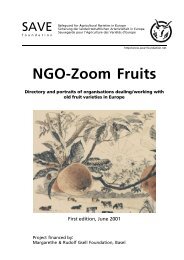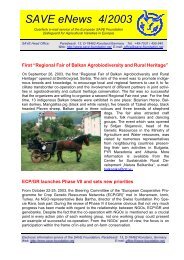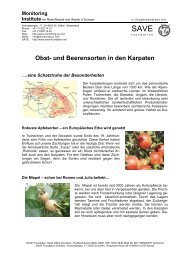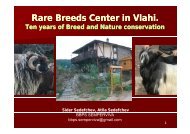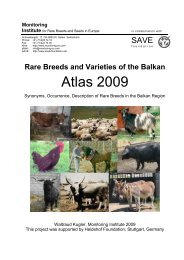Donkey Breeds in Europe - Safeguard for Agricultural Varieties in ...
Donkey Breeds in Europe - Safeguard for Agricultural Varieties in ...
Donkey Breeds in Europe - Safeguard for Agricultural Varieties in ...
You also want an ePaper? Increase the reach of your titles
YUMPU automatically turns print PDFs into web optimized ePapers that Google loves.
were crossed with Onagers <strong>in</strong> order to breed stronger and larger draught animals<br />
<strong>for</strong> the mach<strong>in</strong>es of war.<br />
In 2000BC donkeys began to spread <strong>in</strong>to <strong>Europe</strong>, probably through the Etruscans.<br />
The donkey arrived <strong>in</strong> Spa<strong>in</strong> and Italy via Marroco. Both on the Iberian and the Appen<strong>in</strong>e<br />
pen<strong>in</strong>sulas there are rock pa<strong>in</strong>t<strong>in</strong>gs to be found, dat<strong>in</strong>g from 2000BC, upon<br />
which one can see donkeys <strong>in</strong> use as domesticated animals.<br />
In Greece, mules and donkeys were used <strong>for</strong> many types of work: <strong>in</strong> agriculture,<br />
transport and <strong>in</strong> the army. The importance of these animals differed from region to<br />
region: <strong>in</strong> some places donkeys were carefully bred, <strong>in</strong> others the donkey was considered<br />
a lowly animal and treated accord<strong>in</strong>gly.<br />
The Romans spread the donkey further <strong>in</strong>to <strong>Europe</strong> dur<strong>in</strong>g their campaign of conquest:<br />
from Spa<strong>in</strong> through to Hungary, to Germany and Great Brita<strong>in</strong>. In most regions,<br />
after the fall of the Roman Empire, they disappeared aga<strong>in</strong>. However, <strong>in</strong> the<br />
Mediterranean olive and w<strong>in</strong>e grow<strong>in</strong>g areas, the donkey rema<strong>in</strong>ed an important<br />
part of agriculture. Due to their surefootedness, donkeys were also used as pack<br />
animals <strong>in</strong> mounta<strong>in</strong>ous areas. In Central <strong>Europe</strong>, the donkey was re<strong>in</strong>troduced <strong>in</strong><br />
the middle Ages by monks <strong>for</strong> use <strong>in</strong> farm<strong>in</strong>g, <strong>for</strong> merchants and craftsfolk, <strong>for</strong> the<br />
supply<strong>in</strong>g of castles and mill<strong>in</strong>g gra<strong>in</strong>s.<br />
At the beg<strong>in</strong>n<strong>in</strong>g of 1BC donkeys were also <strong>in</strong>troduced <strong>in</strong>to India, the Malaysian<br />
archipelago, Ch<strong>in</strong>a and Mongolia. In the 16th century the Spanish <strong>in</strong>troduced them<br />
<strong>in</strong>to the cont<strong>in</strong>ent of South America.<br />
Characteristics<br />
In contrast to other domesticated animals, the donkey has seen no fundemental<br />
changes <strong>in</strong> use or the development of the animal <strong>in</strong> its 7000 years of domestication.<br />
Due to the differences <strong>in</strong> breed<strong>in</strong>g, region, husbandry and climate conditions, many<br />
physical differences can be found. Systematic breeds are rare. Often, even these<br />
are not exactly def<strong>in</strong>ed, unlike the case of other livestock breeds.<br />
Domesticated donkeys weigh between 80 and 480 kg, the withers height ranges<br />
from 80 to 160 cm. They live on average 30 to 35 years, they can, however, live<br />
significantly longer and can carry on work<strong>in</strong>g up to a great age. The number of<br />
chromosomes is 62. To compare: horses have 64 chromosones, zebras 46 (Equus<br />
grevy).<br />
Sires are sexually mature at three years, mares at one year. The mat<strong>in</strong>g time runs<br />
from April to July. Normally, the young are born after 12-13 month gestation.<br />
Multiple births are rare.<br />
<strong>Donkey</strong>s are most valued <strong>for</strong> their ease of care, resistence to disease and stam<strong>in</strong>a.<br />
They have few needs, are harmonious <strong>in</strong> character, perserver<strong>in</strong>g, patient and unflagg<strong>in</strong>g.<br />
Exactly because of these qualities they have often found themselves<br />
badly handled and tormented.<br />
When donkeys are mistreated they become, not only stubborn, but they also bite.<br />
This can rema<strong>in</strong> the case even when a new owner treats them well. However, if a<br />
donkey is well treated it becomes a trusty companion. <strong>Donkey</strong>s are “herd animals”<br />
11





